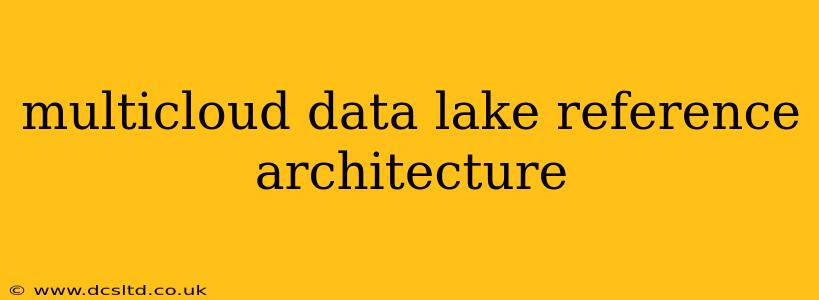The modern enterprise relies on data—massive amounts of it, spread across diverse sources. A single cloud provider often proves insufficient to handle this complexity, leading to the rise of the multicloud data lake. This architecture offers scalability, resilience, and flexibility, but requires careful planning and execution. This guide provides a comprehensive reference architecture, addressing key considerations and answering frequently asked questions.
What is a Multicloud Data Lake?
A multicloud data lake leverages the strengths of multiple cloud providers to store and process vast quantities of structured, semi-structured, and unstructured data. Unlike traditional data warehouses, it doesn't require pre-defined schemas, allowing for greater agility and the ability to handle evolving data needs. This approach mitigates vendor lock-in, improves disaster recovery capabilities, and enables optimal cost management by leveraging the most competitive services from each cloud provider.
Key Components of a Multicloud Data Lake Reference Architecture
A robust multicloud data lake architecture comprises several crucial components working in harmony:
1. Data Ingestion:
This is the critical first step, encompassing the collection and transfer of data from various sources. Methods include:
- Cloud-Native Tools: Leverage each provider's services (e.g., AWS Glue, Azure Data Factory, Google Cloud Dataflow) for efficient data ingestion.
- Third-Party ETL/ELT Tools: Utilize industry-standard tools like Informatica, Talend, or Matillion to orchestrate data pipelines across multiple clouds.
- API Integration: Directly integrate with applications and databases via APIs for seamless data transfer.
2. Data Storage:
Choosing the right storage solution is crucial for performance and cost optimization. This might involve:
- Object Storage: Cost-effective for storing large amounts of unstructured data (e.g., AWS S3, Azure Blob Storage, Google Cloud Storage).
- Data Lakes on Each Cloud: Distributing data across providers to optimize for location, cost, or specific service features.
- Data Warehousing Services: Integrating cloud-based data warehouses (e.g., Snowflake, BigQuery, Redshift) for analytical processing.
3. Data Processing and Analytics:
This stage involves transforming and analyzing the data to extract insights. Consider:
- Serverless Computing: Employ serverless functions (e.g., AWS Lambda, Azure Functions, Google Cloud Functions) for scalable and cost-efficient data processing.
- Managed Data Processing Services: Utilize managed services like Spark clusters (e.g., Databricks, EMR, Azure HDInsight) for parallel data processing.
- Machine Learning (ML) and Artificial Intelligence (AI): Integrate ML/AI services from each cloud provider to build predictive models and automate insights extraction.
4. Data Governance and Security:
Maintaining data quality, security, and compliance is paramount. This includes:
- Access Control: Implement granular access control policies using Identity and Access Management (IAM) services from each cloud provider.
- Data Encryption: Encrypt data at rest and in transit to protect sensitive information.
- Data Catalog and Metadata Management: Maintain a comprehensive catalog of data assets to improve discoverability and understanding.
- Compliance and Auditing: Ensure compliance with relevant regulations (e.g., GDPR, HIPAA) through auditing and monitoring.
5. Data Visualization and Reporting:
Finally, visualizing and presenting data insights is crucial for effective decision-making.
- BI Tools: Integrate business intelligence (BI) tools (e.g., Tableau, Power BI) to create dashboards and reports.
- Custom Dashboards: Develop custom dashboards using cloud-native visualization services.
Frequently Asked Questions (PAA)
Q: What are the benefits of a multicloud data lake?
A: Multicloud data lakes offer enhanced scalability, resilience (through redundancy across providers), vendor lock-in avoidance, better cost optimization by leveraging competitive pricing across providers, and improved geographic reach and compliance by strategically placing data closer to users or regulatory requirements.
Q: What are the challenges of implementing a multicloud data lake?
A: Challenges include increased complexity in managing multiple environments, ensuring data consistency and governance across different platforms, managing data transfer costs and latency between clouds, and coordinating security and compliance across disparate systems. Careful planning and selection of appropriate tools are essential to mitigate these challenges.
Q: How do I ensure data consistency in a multicloud data lake?
A: Maintaining data consistency requires implementing robust data governance policies, utilizing data synchronization tools, and employing techniques like data versioning and change data capture. Regular data quality checks and validation are also vital.
Q: What security considerations are important for a multicloud data lake?
A: Security is paramount. This involves implementing strong authentication and authorization mechanisms (IAM), encrypting data at rest and in transit, regularly monitoring for threats, and adhering to strict compliance regulations. Consider implementing a centralized security information and event management (SIEM) system for visibility across all cloud environments.
Q: What are the best practices for designing a multicloud data lake?
A: Best practices include starting small and iteratively expanding, carefully selecting appropriate cloud services for your specific needs, establishing clear data governance policies, ensuring robust security measures are in place, and investing in monitoring and management tools for optimal performance and efficiency.
This comprehensive guide provides a solid foundation for understanding and implementing a robust multicloud data lake architecture. Remember that the specific implementation will vary depending on the organization's unique requirements and data landscape. Consult with experienced cloud architects and data engineers to tailor the architecture to your specific needs.
